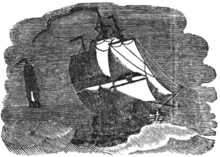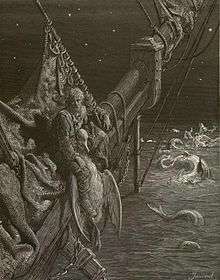Simon Hatley
| Simon Hatley | |
|---|---|
| Born |
27 March 1685 Woodstock, Oxfordshire, England |
| Died | After 1723 |
| Nationality | British |
| Occupation | Sailor |
| Known for | Inspiring The Rime of the Ancient Mariner |
Simon Hatley (27 March 1685 – after 1723) was an English sailor involved in two hazardous privateering voyages to the South Pacific Ocean. Both times he was captured and imprisoned by the Spanish. In 1709 he sailed with Alexander Selkirk, a likely model for Robinson Crusoe,[1] and William Dampier, favoured in Gulliver's Travels as a mariner comparable to Lemuel Gulliver.[2]
Yet Hatley is best remembered for the single act of killing an albatross during the second voyage in 1719 when his ship was buffeted by storms off Cape Horn, an episode immortalised by Samuel Taylor Coleridge in a narrative poem called The Rime of the Ancient Mariner.
Early life
The oldest child in a family of haberdashers of hats, Simon Hatley was born on 27 March 1685 in Woodstock, Oxfordshire, England. The family was a prosperous one, owning a large house and three other rental properties on the High Street. The residence was pulled down and rebuilt in 1704, after he had left home. Fittingly for the family of a son with piratical leanings, it was said to have been built with stones pilfered from the nearby construction site of Blenheim Palace.[3]
Literate in Latin as well as English, he would have attended the Woodstock Grammar School located up the road from where he lived. Some time around 1699, he was apprenticed as a pilot in Bristol, completing his formal training in 1706 at the latest. Two years thereafter, at the age of twenty-three, he signed on as third mate of the Duchess. The vessel was then being readied for a long and difficult journey to the Pacific coast of South America.[4]
Privateering career
Much of what is known about Hatley's subsequent life is in connection with the two privateering voyages that he made to the South Pacific.[5] Privateers were men who sailed in armed merchant ships carrying letters of marque from their government authorising them to plunder foreign enemies, keeping any profits for themselves and their ships' owners.[6] The first such voyage made by Hatley was during the War of the Spanish Succession between Britain and Spain.[7]
Voyage with Rogers

Hatley left Bristol in the Duchess on 1 August 1708, accompanied by a second ship, the Duke, under the overall command of Captain Woodes Rogers.[8] In early February 1709, after beating their way around Cape Horn, the two vessels stopped at the uninhabited Juan Fernández Islands 670 km (420 mi) off the coast of Chile for resupply. The landing party was surprised to be met by one Alexander Selkirk, a Scottish sailor who had been left there by his captain more than four years before and was clearly overjoyed at being rescued.[9] The Duke's pilot, William Dampier, had also been on that earlier, ill-fated cruise with Selkirk, though in a different ship.[10]
For a time, while Selkirk and Dampier were both serving aboard the Duke, Hatley joined them. The privateers were by nature suspicious and wanted careful record-keeping of their prize money. They appointed Hatley as one of their plunder managers to make sure that the two ships' crews were not withholding anything from each other.[11] Opportunities for plundering were soon found. Leaving Juan Fernández on 14 February for the Spanish Main, they captured several vessels, while negotiating the ransom of the town of Guayaquil in present-day Ecuador by first threatening to burn it.[12]
Rogers' flotilla would ultimately circumnavigate the globe,[13] but Hatley did not make it that far. He was put in charge of one of the prize ships captured by the expedition. The other vessels lost contact with his ship in August 1709 near the Galápagos Islands. They searched for him, but without success. A lack of water forced him to make landfall on the mainland, just south of the equator, where he and his men were taken prisoner by the Spanish. Despite having given themselves up voluntarily, they were severely abused. Hatley was kept in a jail in Lima, Peru, until the war's end.[14]
The timing of his return to England was fortunate. Following his separation from them, the privateers had managed to capture a Manila galleon, the Nuestra Señora de la Encarnación y Desengaño, along the coast of Mexico,[15] and amassed a total of £147,975[16] (equivalent to £20 million today)[17] in plundered goods. By the time he made it home late in 1713, two years after Rogers' return, the Chancery Court was just beginning to distribute the proceeds from the voyage. As a junior officer, Hatley received £180—enough perhaps to buy one or two houses in Woodstock. Common sailors got far less.[16] It was some compensation for the years of imprisonment.
Shelvocke expedition

When the War of the Quadruple Alliance brought a renewal of hostilities, Hatley joined another privateering expedition departing Plymouth on 13 February 1719 as second captain under George Shelvocke in the Speedwell.[18] Hatley was already familiar with their South Pacific destination.[19] With Speedwell beset by storms near Cape Horn, he shot an albatross, fearing its black colour was a bad omen, and hoping that once the bird was dead they would have better winds.[20] If this act, as the poet Samuel Taylor Coleridge saw it, angered the spirits,[21] then retribution was not long in coming.
Eventually making their way past the Horn in December 1719, the privateers were able to take a number of Spanish prizes along the coast of Chile, keeping one of them, a barque which they called the Mercury, as a supply ship.[22] While commanding Mercury off the Peruvian coast near Paita in March 1720, Hatley was captured by the Spanish for the second time.[23]
Brought to Lima, his former jailers were far from pleased to see him. They accused him of piracy over the looting of a neutral Portuguese ship off Cape Frio, Brazil, on 5 June the previous year. A purse found among his possessions with 96 moidores could well be all the evidence they needed to hang him. They did not believe his claim that the money was a gift from the ship's captain. But the war had ended in February 1720, and Spain did not want to create tensions with Britain. All of the English sailors were released—except Hatley. He was kept chained and in solitary confinement.[24]
Meanwhile, Captain Shelvocke and his remaining men, having transferred into a prize they renamed Happy Return, were engaged in piracy of a less ambiguous kind. The end of the conflict made their letter of marque invalid, yet they continued to take further valuable prizes before beating a hasty retreat across the Pacific.[25] The Spanish authorities might have expected the arrival of peace to protect them from such predations. The appalling example set by his former commander was of indirect benefit to Hatley, however, as Shelvocke came to be seen as the one primarily responsible for the lawless acts.[26]
Later life
Hatley was finally released from prison in 1723 and made his way back to England.[27] Unlike the prior voyage, there would be no share of the profits awaiting him. Plunder had either been divided up among the crew on the spot[28] or, as some suspected, secretly kept by Shelvocke. Little is known of Hatley following his return from Lima. With the threat of a further trial for piracy hanging over him, he left England soon after for Jamaica where he probably found employment as a sailor.[29] The date, location and circumstances of his death are unknown.
Literary influence
According to William Wordsworth, the poem The Rime of the Ancient Mariner was conceived while he and Coleridge were out walking together in the Quantock Hills of Somerset in November 1797. The discussion turned to a book that Wordsworth was reading, Shelvocke's A Voyage Round the World by Way of the Great South Sea, wherein the incident of Hatley shooting the albatross is told. "Much the greatest part of the story was Coleridge's invention", Wordsworth later wrote, though it was his suggestion that the main plot device of the narrative should involve the killing of an albatross in the South Sea, for which "the tutelary spirits of these regions take upon them to avenge the crime."[30] Hatley's impetuous deed would live forever in verse.
| Wikisource has the original text of Samuel Taylor Coleridge's: |
"God save thee, ancient Mariner!
From the fiends, that plague thee thus!—
Why look'st thou so?"—With my cross-bow
I shot the ALBATROSS.
Notes
- ↑ Severin (2002), pp. 17–19.
- ↑ Swift (1726), p. xi.
- ↑ Fowke (2010), pp. 4, 8–9. The three-storey house on Woodstock High Street can still be found by walking towards the Town Hall, "just past Freeman's the Butcher," at No. 6.
- ↑ Fowke (2010), pp. 9–10, 15.
- ↑ Fowke (2010), pp. 1–3.
- ↑ Fowke (2010), pp. 45–46.
- ↑ Fowke (2010), p. 2.
- ↑ Rogers (1712), pp. 2, 7.
- ↑ Rogers (1712), pp. 125, 129.
- ↑ Rogers (1712), p. 6. Listed among the "officers of the Duke ... William Dampier, pilot for the South-Seas, who had been already three times there, and twice round the world".
- ↑ Rogers (1712), pp. 140–142.
- ↑ Rogers (1712), pp. 172–173, 183.
- ↑ Rogers (1712), p. 427.
- ↑ Rogers (1712), p. 332.
- ↑ Rogers (1712), pp. 293–294.
- 1 2 Fowke (2010), p. 134.
- ↑ Clark, Gregory (2016). "The Annual RPI and Average Earnings for Britain, 1209 to Present". MeasuringWorth. Retrieved 13 March 2016.
- ↑ Shelvocke (1726), pp. 2, 6–7.
- ↑ Severin (2002), pp. 62.
- ↑ Shelvocke (1726), pp. 72–73.
- ↑ Holmes (1989), pp. 171–172; cf. Severin (2002), p. 63, "Albatross were sometimes killed for food by hungry sailors. They set special fishing lines ... to catch the giant sea birds."
- ↑ Betagh (1728), pp. 124–125.
- ↑ Betagh (1728), pp. 240, 244.
- ↑ Fowke (2010), pp. 168–169.
- ↑ Severin (2002), pp. 93–94.
- ↑ Betagh (1728), pp. 252–253.
- ↑ Betagh (1728), p. 33.
- ↑ Severin (2002), p. 63.
- ↑ Fowke (2010), pp. 183–184, 192. Quoting Betagh (1728), p. 33, "Having arrived in London, he 'went immediately for Jamaica, never showing his face to any one of the owners' ".
- ↑ Holmes (1989), p. 171.
References
- Betagh, William (1728). A Voyage Round the World: Being an Account of a Remarkable Enterprise Begun in the Year 1719. London: T. Combes.
- Fowke, Robert (2010). The Real Ancient Mariner: Pirates and Poesy on the South Sea. Bishop's Castle, Shrops.: Travelbrief Publications. ISBN 978-09-548-3514-9.
- Holmes, Richard (1989). Coleridge: Early Visions, 1772–1804. New York: Pantheon Books. ISBN 978-067-08-0444-3.
- Rogers, Woodes (1712). A Cruising Voyage Round the World: First to the South-Sea, Thence to the East-Indies, and Homewards by the Cape of Good Hope. London: A. Bell.
- Severin, Tim (2002). In Search of Robinson Crusoe. New York: Basic Books. ISBN 978-046-50-7698-7.
- Shelvocke, George (1726). A Voyage Round the World by Way of the Great South Sea. London: J. Senex.
- Swift, Jonathan (1726). Gulliver's Travels. London: Penguin Books. ISBN 978-014-31-1911-1.
External links
- "Advice to Pirates" by Robert Fowke (18 November 2010) in The Guardian
- "Uncovered: the Man Behind Coleridge's Ancient Mariner" by Vanessa Thorpe (31 January 2010) in The Observer